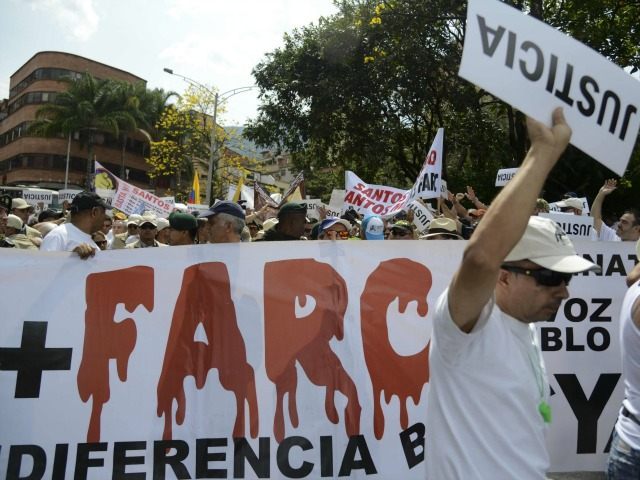A new poll shows that, despite public support for a peace deal with the FARC terrorist group, a significant portion of the population of Colombia remains uncomfortable with the idea of FARC terrorists abandoning the guerrilla lifestyle and settling into civilian life.
Both on the local level in areas particularly devastated by the Revolutionary Armed Forces of Colombia (FARC) during their half of century of violence against the state and civilians in rural areas and on a national scale, Colombians appear deeply uncomfortable with having a former FARC terrorist as their neighbor. A study by Colombian Eafit University’s Center for Political Analysis found that half of Colombians nationally would not be willing to have a former FARC terrorist live in their neighborhood.
Colombia newspaper El Tiempo found that a smaller, but still significant, number of people feel the same in Medellín, the second-largest city in Colombia and one previously ravaged by FARC violence. 34 percent of Medellín residents said they would prefer not to have a former FARC terrorist living in their neighborhood. To compare, Colombian newspaper El Tiempo notes that only 16 percent of people in Medellín say they would be uncomfortable with having a neighbor who had been in prison, and 27 percent would be uncomfortable with a homeless neighbor.
Getting comfortable with former FARC terrorists as neighbors will become a new reality for many Colombians in light of the peace accord President Juan Manuel Santos struck with the terrorist group’s leadership in Havana, Cuba. Santos and “Timochenko,” the leader of the FARC, announced an agreement alongside communist dictator Raúl Castro in September, in which the Colombian government would agree to establishing a special tribunal for terrorists in which they would be tried and sentenced at a faster pace. These tribunals would not subject terrorists to jail time should their crimes be found to have been “political.” Many critics have objected to the contrived difference between “political crimes” and “crimes against humanity,” which may result in many drug traffickers not receiving jail time if their crimes are found to be “political.”
Those escaping jail time will be put on probation and restricted in where they can travel, but they will retain the ability to resettle in cities and, the government hopes, find jobs and homes quickly. Many are expecting to restart their lives in Medellín, which was a thriving hub of drug trafficking through much of the 1970s and 1980s. “Discrimination,” as El Tiempo describes it, could be a major hurdle in reintegrating former terrorists into communities.
“We have to be prepared to understand the value of ex-combatants,” Sebastián Londoño, the head of Colombians Public Office of Security, told El Tiempo. “They assume a great risk by returning to society.”
There are currently no estimates available as to how many former FARC terrorists may return to civilian life, El Tiempo notes. There are currently, however, 431 former FARC terrorists living in Medellín who had chosen to abandon their guerrilla lives before the peace deal. There are significantly more former paramilitaries that belonged to the right-wing United Self-Defense Forces of Colombia (AUC): 1,861.
Medellín’s history of being the world’s most violent city in the 1970s and ’80s was largely a product of drug traffickers, including the infamous Pablo Escobar, establishing their headquarters there. Local government and police structures were too weak to prevent the growth of this industry for years; as The Guardian notes, the city had 49 mayors in 40 years between 1948 and 1988. Two waves of revolutionized governance helped turn it into one of the nation’s most developed economic capitals. In the 1990s, especially following Escobar’s death, the government began efforts to expand public transportation, education, and security. These efforts succeeded temporarily before the FARC and other paramilitary groups took over where the drug lords left off.
Medellín’s second revival occurred in the mid-2000s, under the leadership of Mayor Sergio Fajardo and President Álvaro Uribe, himself a Medellín native. The government provided construction opportunities to build new schools and libraries while offering ways to make money to men who would otherwise consider working with the guerrillas and drug traffickers. Uribe went to work on a national level, meanwhile, on building a more robust military.
With the aid of President George W. Bush, Uribe’s military and the CIA used counterterrorism tactics developed for use against Al Qaeda in Afghanistan to eliminate most of the FARC’s upper-level leadership, decimating the group and forcing the survivors to seek refuge in Havana. Uribe is still currently a senator of Colombia’s Congress, having left office with an 80 percent approval rating.
Medellín citizens fear that Santos’ softer touch on the FARC will result in a relapse to violence. “Uribe stopped all the violence, but Santos wants to talk to them? It’s crazy. They killed a lot of intellectuals and good people who could have helped this country,” Albert Loiza, a coffee grower, told The Telegraph, adding, “the peace talks are a farce.” “Before Uribe, there was no peace in Medellín,” adds a man who only identifies himself as Mauricio.
Santos is currently proposing a ceasefire with the FARC beginning on New Years’ Day. The group remains the world’s wealthiest non-jihadist terrorist organization.

COMMENTS
Please let us know if you're having issues with commenting.